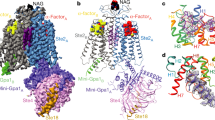Abstract
Paired basic residues have been observed as sites of proteolytic processing of prohormones in a wide range of eukaryotic species1–3. This strongly suggests that proteases exhibiting specificity towards paired basic residues may be involved in prohormone processing, but candidate enzymes have not so far been identified. Yeast Saccharomyces cerevisiae α-cells synthesize and secrete α-mating factor, a peptide of 13 amino acids4,5, the processing of which from a larger precursor involves cleavage at paired basic residues (-Lys-Arg-)3,6. We have therefore used them as a simple model system for the study of prohormone processing and report here the identification, in cell lysates, of a novel protease which specifically recognizes and cleaves the peptide bonds between consecutive basic residues. The purified enzyme, which we have called pro-pheromone-convertase Y, has a molecular weight (MW) of around 43,000. It cleaves various peptide substrates at paired basic residues, but not at single basic residues, implying it is distinct from trypsin-like proteases. Its unique substrate specificity suggests the enzyme may be involved in propheromone processing in vivo.
This is a preview of subscription content, access via your institution
Access options
Subscribe to this journal
Receive 51 print issues and online access
$199.00 per year
only $3.90 per issue
Buy this article
- Purchase on Springer Link
- Instant access to full article PDF
Prices may be subject to local taxes which are calculated during checkout
Similar content being viewed by others
References
Docherty, K. & Steiner, D. F. A. Rev. Physiol. 44, 625–638 (1982).
Mains, R. E., Eipper, B. A., Glembotski, C. C. & Dores, R. M. Trends Neurosci. 6, 229–235 (1983).
Kurjan, J. & Herskowitz, I. Cell 30, 933–943 (1982).
Stölzier, D. & Duntze, W. Eur. J. Biochem. 65, 257–262 (1976).
Tanaka, T., Kita, H., Murakami, T. & Narita, K. J. Biochem. 82, 1681–1687 (1977).
Julius, D., Blair, L., Brake, A., Sprague, G. & Thorner, J. Cell 32, 839–852 (1983).
Kangawa, K., Mizuno, K., Minamino, N. & Matsuo, H. Biochem. biophys. Res. Commun. 95, 1467–1474 (1980).
Walsh, K. A. Meth. Enzym. 19, 41–64 (1970).
Kanaoka, Y. et al. Chem. pharm. Bull., Tokyo 25, 3126–3130 (1977).
Kilpatrick, D. L., Wahlstrom, A., Lahm, H. W., Blacher, R. & Udenfriend, S. Proc. natn. Acad. Sci. U.S.A. 79, 6480–6483 (1982).
Fletcher, D. J., Quigley, J. P., Bauer, G. E. & Noe, B. D. J. Cell Biol. 90, 312–322 (1981).
Loh, Y. P. & Gainer, H. Proc. natn. Acad. Sci. U.S.A. 79, 108–112 (1982).
Mizuno, K., Miyata, A., Kangawa, K. & Matsuo, H. Biochem. biophys. Res. Commun. 108, 1235–1242 (1982).
Lindberg, I., Yang, H. Y. T. & Costa, E. Biochem. biophys. Res. Commun. 106, 186–193 (1982).
Evangelista, R., Ray, P. & Lewis, R. V. Biochem. biophys. Res. Commun. 106, 895–902 (1982).
Fricker, L. D. & Snyder, S. H. Proc. natn. Acad. Sci. U.S.A. 79, 3886–3890 (1982).
Kitamura, K., Kaneko, T. & Yamamoto, Y. Archs Biochem. Biophys. 145, 402–405 (1971).
Laemmli, U. K. Nature 227, 680–685 (1970).
Author information
Authors and Affiliations
Rights and permissions
About this article
Cite this article
Mizuno, K., Matsuo, H. A novel protease from yeast with specificity towards paired basic residues. Nature 309, 558–560 (1984). https://doi.org/10.1038/309558a0
Received:
Accepted:
Issue Date:
DOI: https://doi.org/10.1038/309558a0
This article is cited by
-
Endopeptidases and prohormone processing
Bioscience Reports (1990)
-
Developmental biochemistry of cottonseed embryogenesis and germination XVIII cDNA and amino acid sequences of members of the storage protein families
Plant Molecular Biology (1986)
-
Pheromone-processing protease of the yeast Saccharomyces cerevisiae
Nature (1985)
-
Pheromone-processing protease of the yeast Saccharomyces cerevisiae (reply)
Nature (1985)
Comments
By submitting a comment you agree to abide by our Terms and Community Guidelines. If you find something abusive or that does not comply with our terms or guidelines please flag it as inappropriate.



